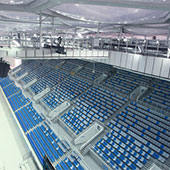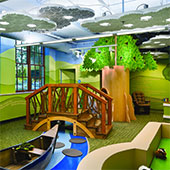Sound and Noise
Sound and noise. We can't see it, but it's everywhere. Leaking into our workplaces, schools, and our bedrooms at night. It's difficult to manage and tricky to regulate. And as cities grow, and more and more people live in proximity to each other, it will become a larger challenge.
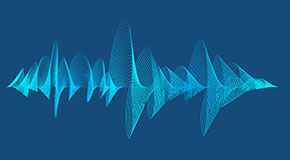
Test Your Knowledge: The health effects of noise
Let's start off with a quiz. How much do you know about the health effects of noise?
Take the test
The major cause of hearing loss is from:
A: Heredity B: Infection C: Workplaces
Correct!
Prolonged exposure to noise during a typical working day leads to hearing loss. Strides have been
made in recent years to set workplace safety standards. However, a recent study from the World
Health Organization (WHO) found that nearly 50% of teenagers and young adults, aged 12-35, are
exposed to unsafe levels of sound from personal audio devices.
No.
Prolonged exposure to noise during a typical working day leads to hearing loss. Strides have been
made in recent years to set workplace safety standards. However, a recent study from the World
Health Organization (WHO) found that nearly 50% of teenagers and young adults, aged 12-35, are
exposed to unsafe levels of sound from personal audio devices.
True or false: Noise has no cognitive effect on children.
Correct!
Cognitive development in children is diminished when homes or schools are noisy. Naturally, that
affects language and reading skills, and ultimately behavioural development.
Incorrect.
Cognitive development in children is diminished when homes or schools are noisy. Naturally, that
affects language and reading skills, and ultimately behavioural development.
Sound levels become dangerous at:
A: 85 dB for 8 hours B: 65 dB for 4 hours C: 75
dB for 5 minutes
Correct!
85 dB for 8 hours.
Source: Noise Pollution: A Modern Plague, Lisa Goines, RN; Louis Hagler, MD
Incorrect.
85 dB for 8 hours.
Source: Noise Pollution: A Modern Plague, Lisa Goines, RN; Louis Hagler, MD
The ABCs of sound dampening
- A
Absorb (via drapes, carpets, ceiling tiles, etc.)
- B
Block (via panels, walls, floors, ceilings and layout)
- C
Cover-up (via sound masking)
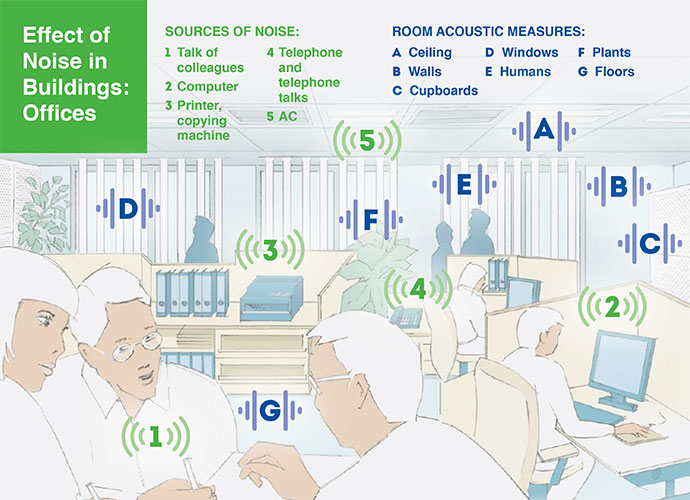
Ceiling
Since the ceiling is usually the largest open space in an office, it absorbs the most sound energy. Lining the ceiling with sound absorbing material will mitigate noise. In larger conference rooms, on the other hand, it may be beneficial that the ceiling is not fully lined to ensure speech intelligibility over greater distances.
Walls
Walls are generally sound hard. If necessary, it is useful to either completely or partially cover walls with acoustically effective materials, or sound-absorbing wall elements.
Cabinets
Cabinet surfaces without special acoustic features reflect sound. Acoustical designed cabinet surfaces—for example, doors—can have a high degree of sound absorption.
People
The human body acts as an absorber. It absorbs about as much sound energy as 0.5 m2 highly absorbent material.
Basotect® Sound Insulation
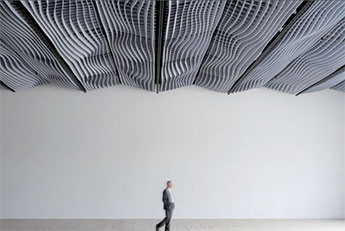
Flexible, open cell foam made from melamine resin, Basotect has a high sound absorption capacity. Flame-proofing agents make Basotect suitable for sound insulation in buildings, air conditioning equipment, and ventilation systems.
Basotect fast facts
- 1
Sound absorption: Open-cell surface guarantees that sound waves are not reflected, but penetrate the cell structure unhindered.
- 2
Fire resistance: Basotect's long-term resistance to high temperatures and excellent fire characteristics are based on the melamine resin used. In the event of a fire, the material does not melt or produce burning droplets.
- 3
Thermal insulation: Basotect provides low thermal conductivity of less than 0.035 W/(m· K). It can reduce energy losses in hot water tanks and solar water heaters, among other examples.
Case study: The National Aquatics Center
The interior of the swimming stadium for the 2008 Beijing Olympics is clad in Basotect®. Read about the National Aquatics Center’s flame-retardant and environmentally friendly acoustic insulation here:
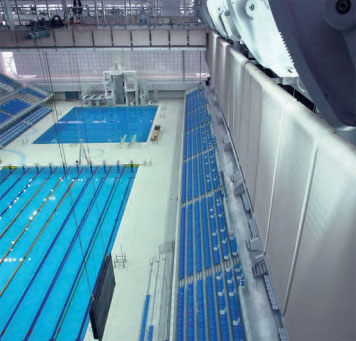
Go in-depth
Want to know more about Basotect?
Doyle Robertson, BASF Regional Business Manager, Basotect, explains what you need to know.
Case study: Versatility in design
Children’s museums are essentially giant indoor playgrounds. The Children's Museum of South Dakota in Brookings, USA uses various acoustic panels made from BASF's melamine resin foam Basotect® for sound absorption and noise control in several rooms and exhibits throughout the museum. The foam's versatility allowed the museum to design acoustic baffles of various shapes that had texture and form such as, for example, a cloud.

Stay Informed |
|
|
Sign up for the latest BASF construction news. |

Help me on my project |
|
-
General
Information -


